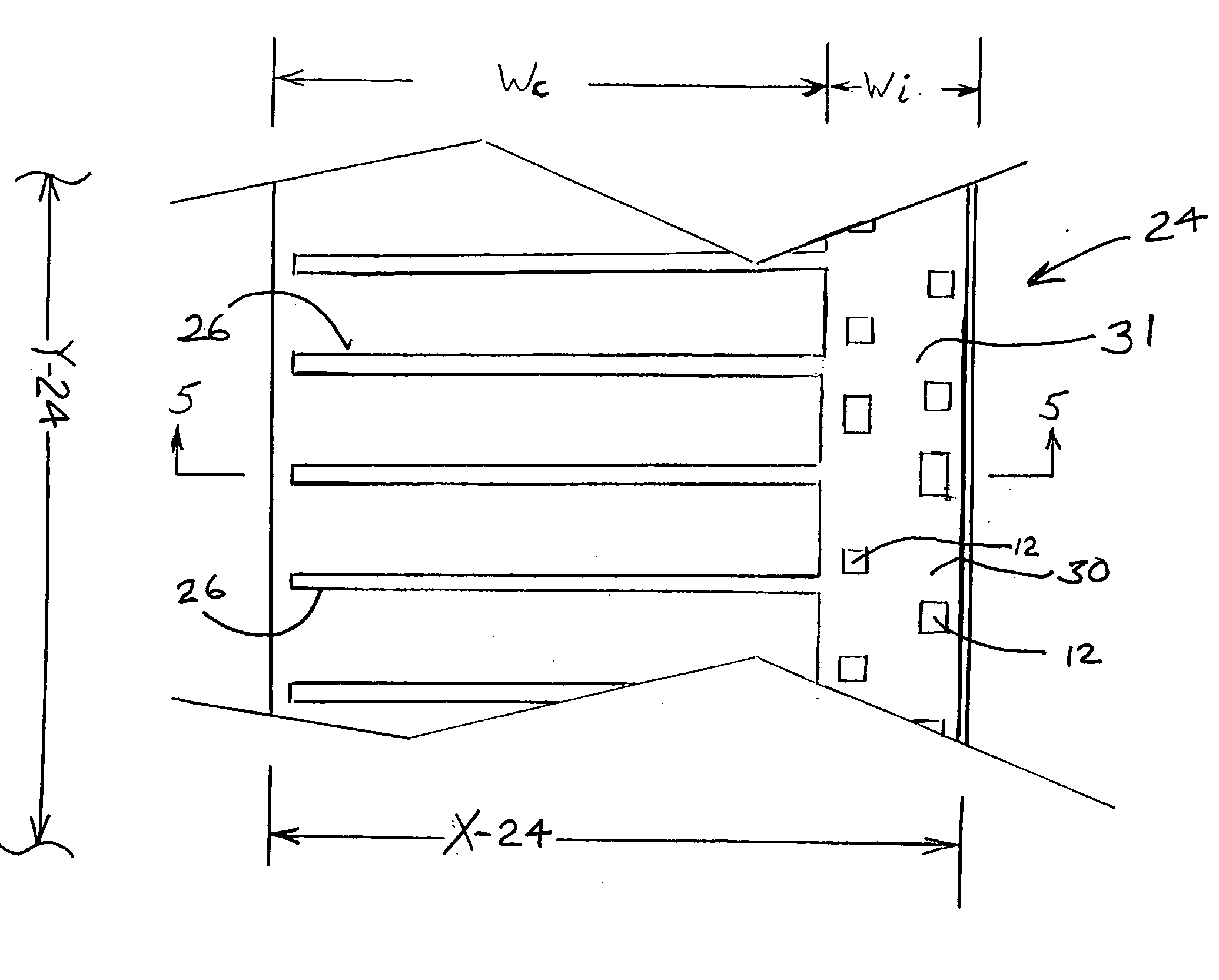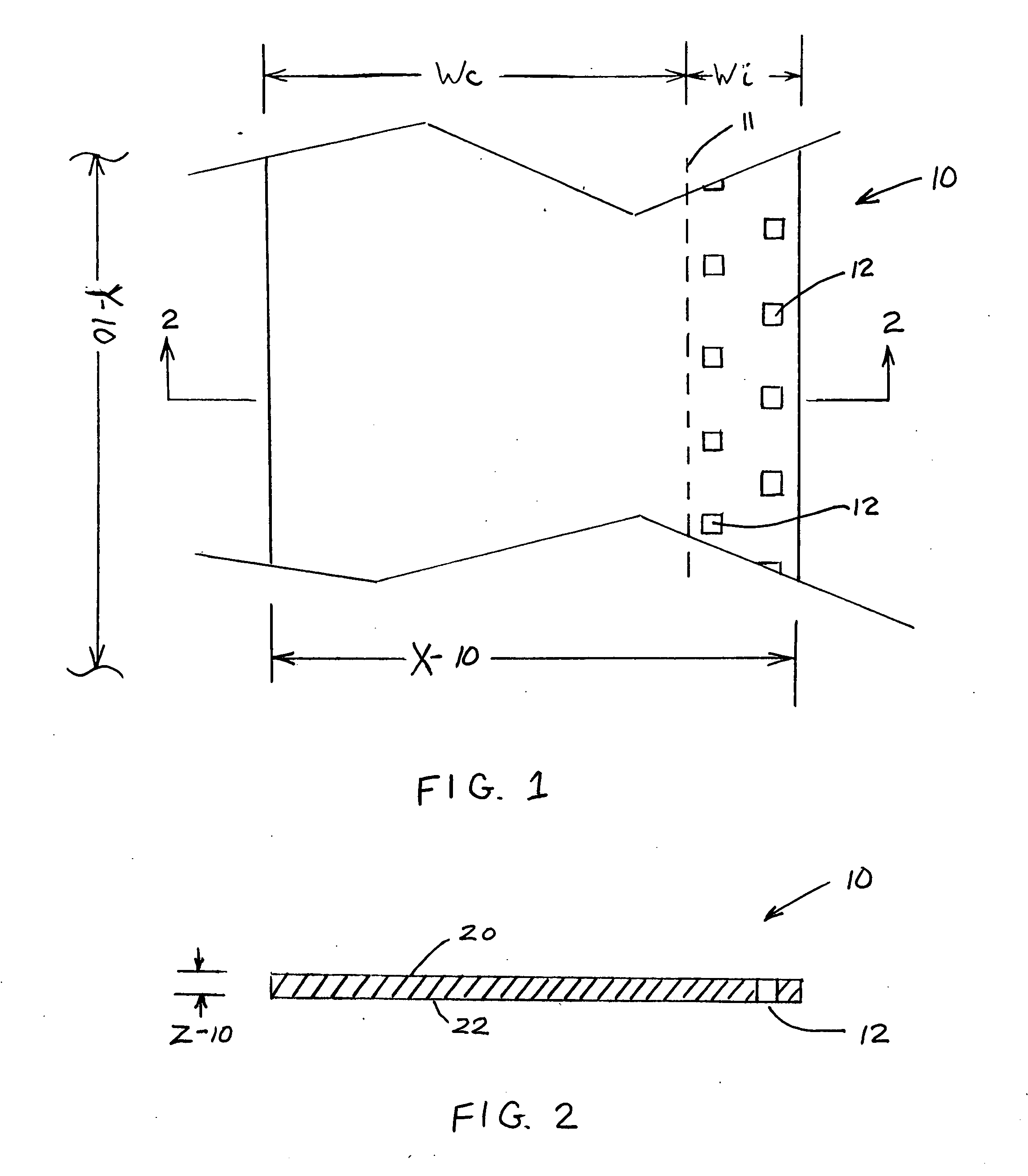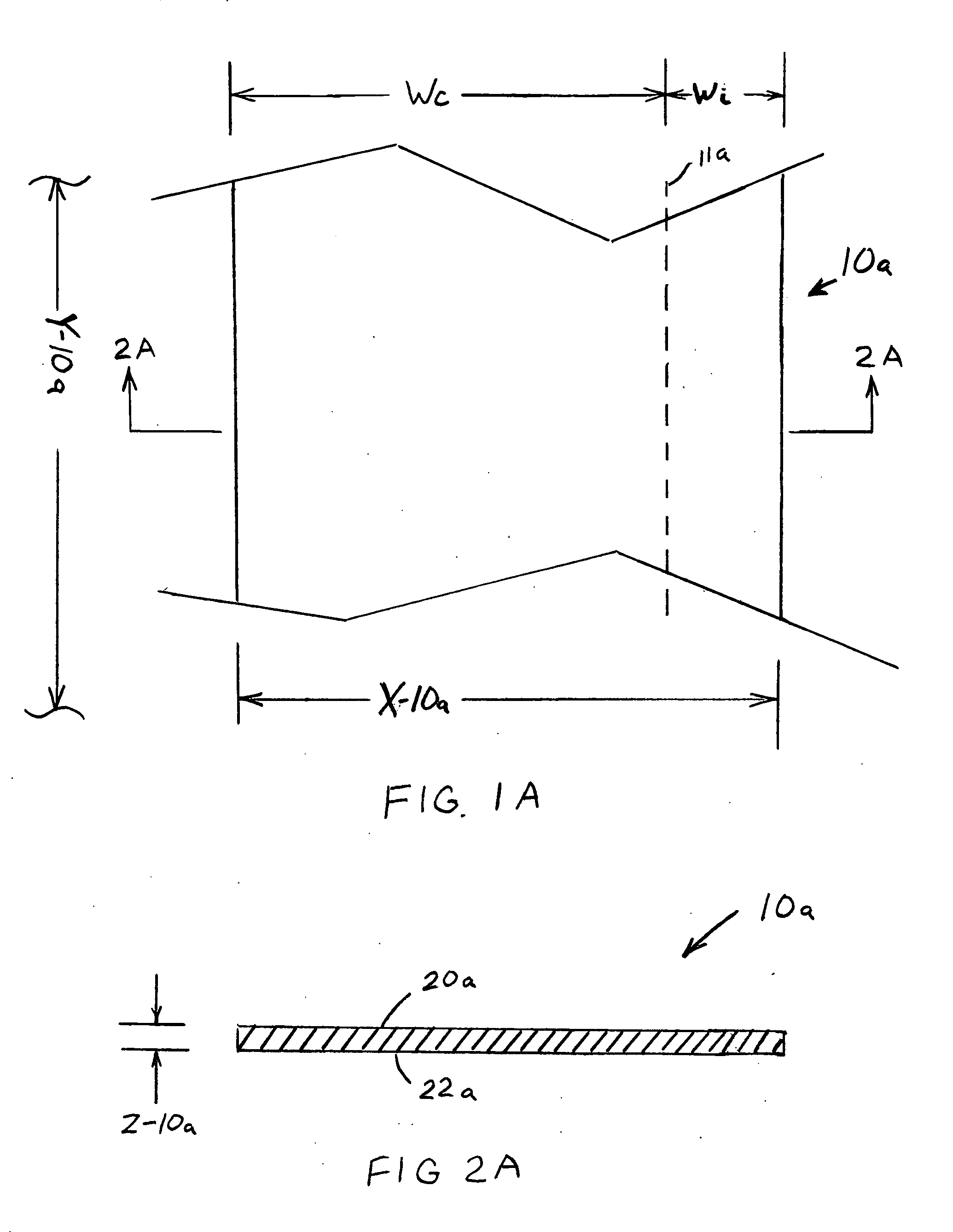Despite significant improvements in individual
cell conversion efficiencies for both
single crystal and thin film approaches, photovoltaic energy collection has been generally restricted to applications having low power requirements.
One factor impeding development of bulk power systems is the problem of economically collecting the energy from an extensive collection surface.
It is readily recognized that making effective, durable series connections among multiple small cells can be laborious, difficult and expensive.
However, a challenge still remains regarding subdividing the
expansive films into individual cells followed by interconnecting into a series connected array.
The electrical resistance of thin vacuum metallized
layers significantly limits the active area of the individual interconnected cells.
However, despite the fact that use of a
metal foil allows high temperature
processing in roll-to-roll fashion, the subsequent
interconnection of individual cells effectively in an interconnected array has proven difficult, in part because the
metal foil substrate is electrically conducting.
These operations add considerably to the final interconnected array cost.
First, many of the chemical elements involved in the best photovoltaic semiconductors are expensive and environmentally unfriendly.
This removal subsequent to controlled deposition involves containment, dust and
dirt collection and disposal, and possible
cell contamination.
This is not only wasteful but considerably adds to expense.
Secondly, the removal processes are difficult to control dimensionally.
Thus a significant amount of the valuable photovoltaic
semiconductor is lost to the removal process.
Ultimate module efficiencies are further compromised in that the spacing between adjacent cells grows, thereby reducing the effective active collector area for a given module area.
A further unsolved problem which has thwarted production of
expansive surface photovoltaic modules is that of collecting the photogenerated current from the top, light incident surface.
These
small cell widths demand very fine interconnect area widths, which dictate delicate and sensitive techniques to be used to electrically connect the top TCO surface of one cell to the bottom
electrode of an adjacent series connected cell.
Furthermore, achieving good stable
ohmic contact to the TCO cell surface has proven difficult, especially when one employs those sensitive techniques available when using the TCO only as the top collector
electrode.
The problem of collecting photovoltaic generated current from the top light impinging surface of a photovoltaic cell has been addressed in a number of ways, none entirely successful.
The process is very sensitive to
processing variables used to fabricate the plastic substrate, limiting applications to carefully molded parts and designs.
In addition, the many steps employing harsh chemicals make the process intrinsically costly and environmentally difficult.
Finally, the sensitivity of ABS plastic to
liquid hydrocarbons has prevented certain applications.
Multiple performance problems thwarted these attempts.
However, because of
fiber separation (holes) such a composite might not exhibit consistent “microscopic” resistivity.
Efforts to produce electrically conductive polymers suitable for direct
electroplating have encountered a number of obstacles.
The first is the combination of fabrication difficulty and material property deterioration brought about by the heavy filler loadings often required.
A second is the high cost of many conductive fillers employed such as silver flake.
Another obstacle involved in the
electroplating of electrically conductive polymers is a consideration of adhesion between the electrodeposited
metal and polymeric substrate (metal /
polymer adhesion).
In some cases such as
electroforming, where the electrodeposited metal is eventually removed from the substrate, metal /
polymer adhesion may actually be detrimental.
However, in most cases sufficient adhesion is required to prevent metal /
polymer separation during extended environmental and use cycles.
However, here the metal particles are generally encapsulated by the resin binder, often resulting in a resin rich “
skin”.
An additional major obstacle confronting development of electrically conductive polymeric resin compositions capable of being directly electroplated is the initial “bridge” of electrodeposit on the surface of the electrically conductive resin.
However, if the
contact resistance is excessive or the substrate is insufficiently conductive, the electrodeposit current favors the metal contact and the electrodeposit may have difficulty bridging to the substrate.
The “bridging” problem extends to substrates having low surface current
carrying capacity such as vacuum metallized or electrolessly plated films.
Moreover, a further problem is encountered even if specialized
racking or contacting successfully achieves electrodeposit bridging to the substrate.
The initial conductive substrate can be relatively limited in the amount of electrodeposition current which it alone can convey.
This restricts the size and “growth length” of the substrate conductive pattern, increases plating costs, and can also result in large non-uniformities in electrodeposit integrity and thickness over the pattern.
These factors of course work against achieving the desired result.
However, attempts to make an acceptable directly electroplateable resin using the relatively small fillers alone encounter a number of barriers.
First, the fine conductive fillers can be relatively expensive.
The loadings required to achieve the particle-to-particle proximity to achieve acceptable
conductivity increases the cost of the polymer / filler blend dramatically.
The fine fillers may bring further problems.
They tend to cause deterioration of the mechanical properties and processing characteristics of many resins.
This significantly limits options in resin selection.
A required heavy loading of filler severely restricts ability to manipulate processing properties in this way.
A further problem is that metal fillers can be
abrasive to processing machinery and may require specialized screws, barrels, and the like.
Finally, despite being electrically conductive, a polymer filled with conductive particles still offers no mechanism to produce adhesion of an electrodeposit since the particles may be essentially encapsulated by the resin binder, often resulting in a non-conductive or non-binding resin-rich “
skin”.
For the above reasons, fine conductive particle containing plastics have not been widely used as bulk substrates for directly electroplateable articles.
However, high material costs, application complexity, electrodeposit growth rate issues and adhesion remain with these approaches.
However, the rates of electrodeposit coverage reported by Adelman may be insufficient for many applications.
As pointed out above in this specification, attempts to dramatically simplify the process of electroplating on plastics have met with commercial difficulties.
One readily recognizes that the demand for such functional applications for electroplated articles is relatively recent and has been particularly explosive during the past decade.
Conventional “electroless” plating technology does not permit this compositional flexibility.
Treatment of both sides of the substrate in a roll to roll process may adversely affect the surface of the DER material and may lead to deterioration in plateability.
For example, it has been observed that primers on both sides of a roll of PET film have adversely affected plateability of DER inks printed on the PET.
Conventional plastic electroplating technology does not permit great flexibility to “custom formulate”.
 Login to View More
Login to View More  Login to View More
Login to View More 


